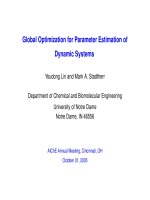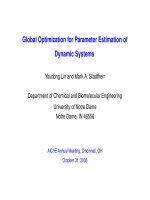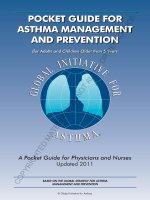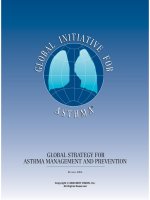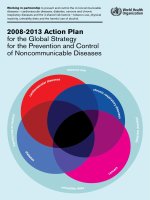Global initiative for asthma
Bạn đang xem bản rút gọn của tài liệu. Xem và tải ngay bản đầy đủ của tài liệu tại đây (2.7 MB, 34 trang )
GINA 2014
DR. TRÌNH THỊ NGÀ
G lobal
INitiative for
A sthma
© Global Initiative for Asthma
INTRODUCTION
Definition and diagnosis of asthma
Assessment of asthma
Treating asthma to control symptoms and
minimize risk
Asthma flare-ups (exacerbations)
Diagnosis and management of asthma in
children
5 years and younger
Primary prevention of asthma
GINA Strategy - major revision
2014
New chapters
Management
of asthma in children 5 years and
younger, previously published separately in 2009
Diagnosis
of asthma-COPD overlap (ACOS): a
joint project of GINA and GOLD
GINA 2014
Burden of asthma
GINA 2014
Asthma is one of the most common chronic
diseases worldwide with an estimated 300
million affected individuals
Prevalence is increasing in many countries,
especially in children
Asthma is a major cause of school and work
absence
Health care expenditure on asthma is very
high
Definition of asthma
Asthma is a heterogeneous disease, usually
characterized by chronic airway inflammation.
It is defined by the history of respiratory symptoms such
as wheeze, shortness of breath, chest tightness and
cough that vary over time and in intensity, together with
variable expiratory airflow limitation.
NEW!
GINA 2014
Diagnosis of asthma
The diagnosis of asthma should be based on:
Document evidence for the diagnosis in the patient’s
notes, preferably before starting controller treatment
GINA 2014
A history of characteristic symptom patterns
Evidence of variable airflow limitation, from bronchodilator
reversibility testing or other tests
It is often more difficult to confirm the diagnosis after
treatment has been started
Asthma is usually characterized by airway
inflammation and airway hyperresponsiveness, but
these are not necessary or sufficient to make the
diagnosis of asthma.
NEW!
GINA 2014, Box 1-1
© Global Initiative for Asthma
Diagnosis of asthma – variable
airflow limitation
Confirm presence of airflow limitation
Document that FEV1/FVC is reduced (at least once, when FEV1 is low)
FEV1/ FVC ratio is normally >0.75 – 0.80 in healthy adults, and
>0.90 in children
Confirm variation in lung function is greater than in healthy
individuals
The greater the variation, or the more times variation is seen, the
greater probability that the diagnosis is asthma
Excessive bronchodilator reversibility (adults: increase in FEV1 >12%
and >200mL; children: increase >12% predicted)
Excessive diurnal variability from 1-2 weeks’ twice-daily PEF monitoring
(daily amplitude x 100/daily mean, averaged)
Significant increase in FEV1 or PEF after 4 weeks of controller treatment
If initial testing is negative:
GINA 2014, Box 1-2
Repeat when patient is symptomatic, or after withholding bronchodilators
Refer for additional tests (especially children ≤5 years, or the elderly)
Typical spirometric tracings
Volume
Flow
Normal
FEV1
Asthma
(after BD)
Normal
Asthma
(before BD)
Asthma
(after BD)
Asthma
(before BD)
1
2
3
4
5
Volume
Time (seconds)
Note: Each FEV1 represents the highest of
three reproducible measurements
GINA 2014
© Global Initiative for Asthma
Assessment of asthma
© Global Initiative for Asthma
GINA assessment of asthma control
GINA 2014, Box 2-2A
© Global Initiative for Asthma
GINA assessment of asthma control
GINA 2014, Box 2-2B
© Global Initiative for Asthma
Assessment of risk factors for poor asthma
outcomes
Risk factors for exacerbations include:
•
•
•
•
Ever intubated for asthma
Uncontrolled asthma symptoms
Having ≥1 exacerbation in last 12 months
Low FEV1 (measure lung function at start of treatment, at 3-6 months
to assess personal best, and periodically thereafter)
• Incorrect inhaler technique and/or poor adherence
• Smoking
• Obesity, pregnancy, blood eosinophilia
Risk factors for fixed airflow limitation include:
• No ICS treatment, smoking, occupational exposure, mucus
hypersecretion, blood eosinophilia
Risk factors for medication side-effects include:
• Frequent oral steroids, high dose/potent ICS, P450 inhibitors
GINA 2014, Box 2-2B
© Global Initiative for Asthma
Treating asthma to control
symptoms and minimize risk
© Global Initiative for Asthma
Goals of asthma management
The long-term goals of asthma management are
1.
2.
Achieving these goals requires a partnership between
patient and their health care providers
GINA 2014
Symptom control: to achieve good control of symptoms
and maintain normal activity levels
Risk reduction: to minimize future risk of exacerbations,
fixed airflow limitation and medication side-effects
Ask the patient about their own goals regarding their
asthma
Good communication strategies are essential
Consider the health care system, medication availability,
cultural and personal preferences and health literacy
The control-based asthma management cycle
NEW!
GINA 2014, Box 3-2
© Global Initiative for Asthma
Initial controller treatment for adults,
adolescents and children 6–11 years
Start controller treatment early
For
best outcomes, initiate controller treatment as
early as possible after making the diagnosis of
asthma
Indications for regular low-dose ICS - any of:
Asthma
symptoms more than twice a month
Waking due to asthma more than once a month
Any asthma symptoms plus any risk factors for
exacerbations
NEW!
GINA 2014, Box 3-4 (1/2)
Initial controller treatment for adults,
adolescents and children 6–11 years
Consider starting at a higher step if:
Troublesome
asthma symptoms on most days
Waking
from asthma once or more a week,
especially if any risk factors for exacerbations
If initial asthma presentation is with an
exacerbation:
Give
a short course of oral steroids and start
regular controller treatment (e.g. high dose ICS or
medium dose ICS/LABA, then step down)
NEW!
GINA 2014, Box 3-4 (1/2)
Stepwise approach to control asthma symptoms
and reduce risk
NEW!
GINA 2014, Box 3-5
© Global Initiative for Asthma
Low, medium and high dose inhaled corticosteroids
Adults and adolescents (≥12 years)
Inhaled corticosteroid
Total daily dose (mcg)
Low
Medium
High
Beclometasone dipropionate (CFC)
200–500
>500–1000
>1000
Beclometasone dipropionate (HFA)
100–200
>200–400
>400
Budesonide (DPI)
200–400
>400–800
>800
Ciclesonide (HFA)
80–160
>160–320
>320
Fluticasone propionate (DPI or HFA)
100–250
>250–500
>500
Mometasone furoate
110–220
>220–440
>440
400–1000
>1000–2000
>2000
Triamcinolone acetonide
GINA 2014, Box 3-6 (1/2)
Low, medium and high dose inhaled corticosteroids
Children 6–11 years
Inhaled corticosteroid
Total daily dose (mcg)
Low
Medium
High
Beclometasone dipropionate (CFC)
100–200
>200–400
>400
Beclometasone dipropionate (HFA)
50–100
>100–200
>200
Budesonide (DPI)
100–200
>200–400
>400
Budesonide (nebules)
250–500
>500–1000
>1000
80
>80–160
>160
Fluticasone propionate (DPI)
100–200
>200–400
>400
Fluticasone propionate (HFA)
100–200
>200–500
>500
110
≥220–<440
≥440
400–800
>800–1200
>1200
Ciclesonide (HFA)
Mometasone furoate
Triamcinolone acetonide
GINA 2014, Box 3-6 (2/2)
Reviewing response and adjusting
treatment
How often should asthma be reviewed?
1-3
months after treatment started, then every 312 months
During pregnancy, every 4-6 weeks
After an exacerbation, within 1 week
Managing exacerbations in primary care
NEW!
GINA 2014, Box 4-3 (1/3)
© Global Initiative for Asthma
Diagnosis and management of
asthma in children 5 years and
younger
© Global Initiative for Asthma

